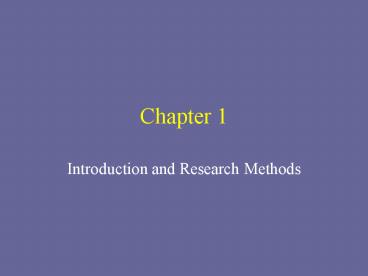Introduction and Research Methods PowerPoint PPT Presentation
1 / 28
Title: Introduction and Research Methods
1
Chapter 1
- Introduction and Research Methods
2
What is Psychology?
- The science of behavior and mental processes
- Behaviorobservable actions of a person or animal
- Mindthoughts, feelings, sensations, perceptions,
memories, dreams, motives and other subjective
experiences - Sciencean objective way to answer questions
based on observable facts/data and well-described
methods
3
Philosophical Developments
BIG
- A Question How are mind and body
related?
- René Descartes (15961650)Interactive dualism
- The mind and body interact to produce conscious
experience
4
Philosophical Developments
BIG
- Another Question Nature vs. Nurture
- Are abilities determined by our genes or our
experiences? - What are the interactions between genetics and
environment? - What effect does it have on behavior?
5
Foundations of Modern Psychology
- Separated from philosophy in 19th century
- influences from physiology remain
- Wilhelm Wundt (18321920)
- Leipzig, Germany
- wrote the first psychology textbook
- applied laboratory techniques to study of the
mind - structuralismidentify atoms of the mind
- focused on basic sensory and perceptual processes
- measured reaction times
6
Wilhelm Wundt (18321920)
7
Other Pioneers
- Edward Titchener (18671927)
- Wundts student, professor at Cornell University
- William James (18421910)
- started psychology at Harvard in 1870s
- opposed Wundt and Titcheners approach
- functionalism influenced by Darwin to focus on
how behaviors help us adapt to the environment - Sigmund Freud (18561939)
- Austrian physician that focused on illness
- psychoanalytic theory of mental disorders
8
E. B. Titchener (18671927)
9
William James (18421910)
10
Other Pioneers
- John B. Watson (18781958)
- psychologists should study overt behavior
- B. F. Skinner (19041990)
- American psychologist at Harvard
- studied learning and effect of reinforcement
- behaviorism
11
John B. Watson (18781958)
12
B. F. Skinner (19041990)
13
Perspectives
- Perspective is a way of viewing phenomena
- Psychology has multiple perspectives
- Biological
- Psychodynamic
- Behavioral
- Humanistic
- Cognitive
- Cross-Cultural
- Evolutionary
14
Biological Perspective
- Study the physiological mechanisms in the brain
and nervous system that organize and control
behavior - Focus may be at various levels
- individual neurons
- areas of the brain
- specific functions like eating, emotion, or
learning - Interest in behavior distinguishes biological
psychology from many other biological sciences
15
Psychodynamic Perspective
- View of behavior based on experience treating
patients - Psychoanalytic approach (Sigmund Freud)
- both a method of treatment and a theory of the
mind - behavior reflects combinations of conscious and
unconscious influences - drives and urges within the unconscious component
of mind influence thought and behavior - early childhood experiences shape unconscious
motivations
16
Behavioral Perspective
- View of behavior based on experience or learning
- Classical conditioning
- Operant conditioning
17
Humanistic Perspective
- Developed by Abraham Maslow and Carl Rogers
- behavior reflects innate actualization
- focus on conscious forces and self perception
- more positive view of basic forces than Freuds
18
Carl Rogers (19021987)
Abraham Maslow (19081970)
19
Cognitive Perspective
- How is knowledge acquired, organized, remembered,
and used to guide behavior? - Influences include
- Piaget studied intellectual development
- Chomsky studied language
- Cybernetics science of information processing
20
Cross-Cultural Perspective
- The study of psychological differences among
people living in different cultural groups - How are peoples thoughts, feelings and behavior
influenced by their culture? - What are the common elements across culture? Are
these innate?
21
Evolutionary Perspective
- Influenced by Darwin and the emphasis on innate,
adaptive behavior patterns - Application of principles of evolution to explain
behavior and psychological processes
22
Scientific Method
- Formulate testable questions
- Develop hypotheses
- Design study to collect data
- Experimental
- Descriptive
- Analyze data to arrive at conclusions
- Use of statistical procedures
- Use of meta-analysis
- Report results
- Publication
- Replication
23
Theory
- Tentative explanation for observed findings
- Results from accumulation of findings of
individual studies - Tool for explaining observed behavior
- Reflects self-correcting nature of scientific
method.
24
Science vs. Common Sense
- Science helps build explanations that are
consistent and predictive rather than conflicting
and postdictive (hindsight) - Science is based on
- knowledge of facts
- developing theories
- testing hypotheses
- public and repeatable procedures
25
Research Strategies
- Descriptivestrategies for observing and
describing behavior - Naturalistic observation
- Case studies
- Surveys
- Correlational methods
- Experimentalstrategies for inferring cause and
effect relationships among variables
26
Definitions
- Hypothesistentative statement about the
relationship between variables - Variablesfactors that can vary in ways that can
be observed, measured, and verified (independent
versus dependent) - Operational definitionprecise description of how
the variables will be measured
27
Samples and Sampling
- Populationlarge (potentially infinite) group
represented by the sample. Findings are
generalized to this group. - Sampleselected segment of the population
- Representative sampleclosely parallels the
population on relevant characteristics - Random selectionevery member of larger group has
equal change of being selected for the study
sample
28
Ethical Guidelines
- Informed consent and voluntary participation
- Students as participants
- Use of deception
- Confidentiality of records
- Information about the study and debriefing

